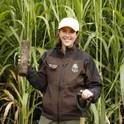
Public agencies and private enterprises increasingly desire to achieve ecosystem service outcomes in agricultural systems, but are limited by perceived conflicts between economic and ecosystem service goals and a lack of tools enabling effective operational management. Here we use Iowa—an agriculturally homogeneous state representative of the Maize Belt—to demonstrate an economic rationale for cropland diversification at the subfield scale. We used a novel computational framework that integrates disparate but publicly available data to map ∼3.3 million unique potential management polygons (9.3 Mha) and reveal subfield opportunities to increase overall field profitability. We analyzed subfield profitability for maize/soybean fields during 2010–2013—four of the most profitable years in recent history—and projected results for 2015. While cropland operating at a loss of US$ 250 ha−1 or more was negligible between 2010 and 2013 at 18 000–190 000 ha (<2% of row-crop land), the extent of highly unprofitable land increased to 2.5 Mha, or 27% of row-crop land, in the 2015 projection. Aggregation of these areas to the township level revealed ‘hotspots’ for potential management change in Western, Central, and Northeast Iowa. In these least profitable areas, incorporating conservation management that breaks even (e.g., planting low-input perennials), into low-yielding portions of fields could increase overall cropland profitability by 80%. This approach is applicable to the broader region and differs substantially from the status quo of ‘top-down’ land management for conservation by harnessing private interest to align profitability with the production of ecosystem services.
Available at: http://works.bepress.com/lisa_schulte/54/

This article is from Environmental Research Letters 11 (2016): 14009, doi: 10.1088/1748-9326/11/1/014009. Posted with permission.